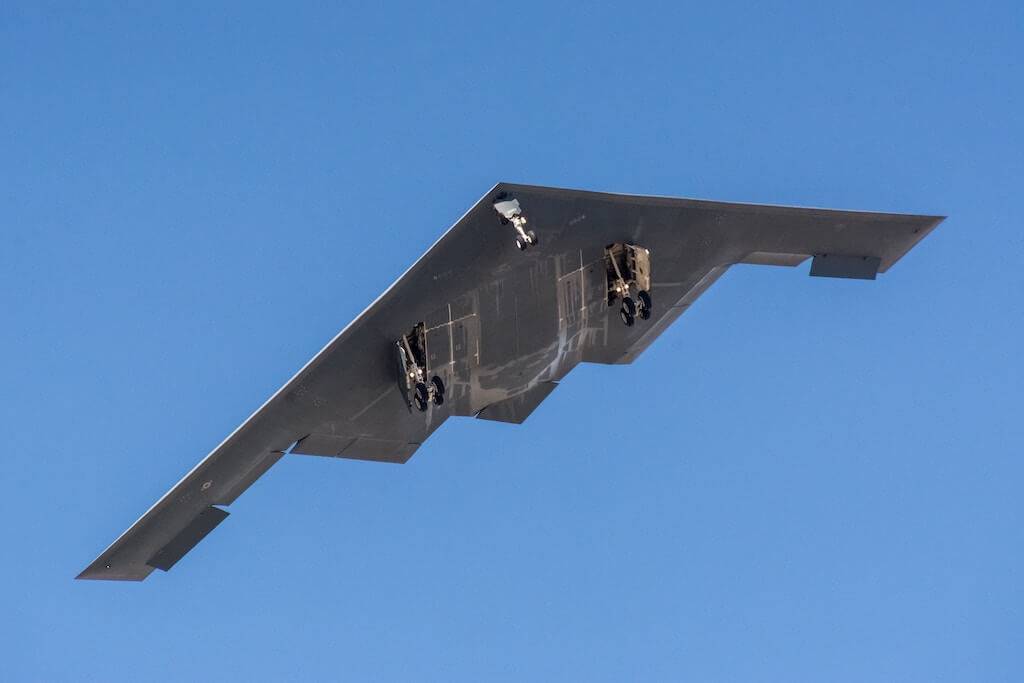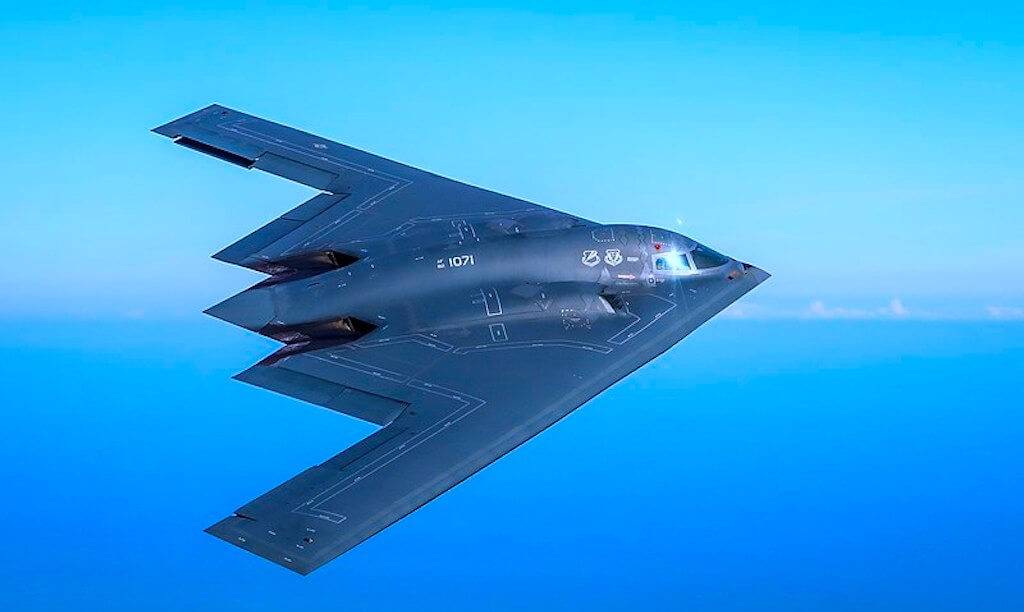Explore the strategic capabilities of the B-2 Spirit Stealth Bomber, an advanced aircraft known for its unmatched stealth and precision. Discover its range, payload capacity, and ability to carry conventional and nuclear weapons, making it an essential asset in modern warfare.
The B-2 Spirit Stealth Bomber is renowned for its exceptional strategic capabilities in modern warfare. This advanced aircraft, also known as the “Stealth Bomber,” is designed to fly undetected by radar, making it a formidable asset for any military operation. Its sleek and innovative design, coupled with its state-of-the-art technology, allows for precise and effective strikes against targets deep within enemy territory. The B-2’s impressive range and payload capacity, along with its ability to carry a variety of conventional and nuclear weapons, make it a crucial component of the United States Air Force’s arsenal. In this article, we will explore the strategic capabilities of the B-2 Spirit Stealth Bomber and shed light on its significance in modern warfare.
Overview
The B-2 Spirit Stealth Bomber is an advanced aircraft that combines cutting-edge technology with strategic capabilities. Designed and developed by Northrop Grumman, this bomber has become a critical asset in the United States Air Force’s inventory. With its unique stealth capabilities, payload capabilities, range and endurance, avionics and sensors, crew and cockpit features, operational flexibility, integration with other forces, maintenance and support requirements, and future upgrade potential, the B-2 Spirit Stealth Bomber stands out as a remarkable machine in the field of aviation.
Design and Development
The design and development of the B-2 Spirit Stealth Bomber required years of research and innovation. The main objective was to create an aircraft that could penetrate enemy airspace undetected, capable of delivering a wide range of payloads with precision. Extensive aerodynamic testing and computer simulations were conducted to ensure optimal performance and low radar cross-section. Additionally, the B-2 Spirit Stealth Bomber’s unique flying wing design helps minimize its infrared signature, making it harder for heat-seeking missiles to track.
Introduction into Service
The B-2 Spirit Stealth Bomber was first introduced into service in the early 1990s. Since then, it has played a crucial role in various military operations, demonstrating its exceptional capabilities. The aircraft is primarily operated by the United States Air Force, utilizing its stealth characteristics to conduct strategic bombing missions and provide support to ground forces. With the B-2 Spirit Stealth Bomber, the Air Force can project power across great distances and strike targets with unparalleled precision.
Primary Role
The primary role of the B-2 Spirit Stealth Bomber is to deliver devastating payloads with precision accuracy. With its state-of-the-art technology, this aircraft can carry both conventional and nuclear weapons, allowing for flexible mission planning. The B-2 Spirit Stealth Bomber’s primary task is to conduct strategic bombing missions, making it an essential asset in the United States’ deterrent strategy. It can also serve as a long-range surveillance and reconnaissance platform, gathering vital intelligence in hostile environments.
Stealth Capability
The B-2 Spirit Stealth Bomber’s stealth capability is one of its most remarkable features. This aircraft utilizes advanced technologies and design techniques to reduce its radar cross-section, diminishing the chances of enemy detection. The combination of its flying wing design, special coatings, and internal weapon storage helps to minimize reflections of radar waves back to the source. The low observability of the B-2 Spirit Stealth Bomber ensures that it can penetrate enemy airspace undetected, enhancing its effectiveness in high-threat environments.
Radar Cross-Section Reduction
To achieve its stealth capabilities, the B-2 Spirit Stealth Bomber employs various methods to reduce its radar cross-section. The aircraft’s outer surfaces are coated with special materials that absorb and scatter radar waves, preventing them from bouncing back to the radar source. Additionally, radar-absorbing materials are used throughout the bomber’s construction, further reducing its reflective properties. These measures significantly decrease the chances of enemy radar systems detecting the B-2 Spirit Stealth Bomber, giving it a decisive advantage in combat situations.
Low Observability
The B-2 Spirit Stealth Bomber’s low observability is a result of its advanced design and construction. The aircraft’s flying wing design eliminates traditional tail surfaces, reducing its vulnerability to detection by radar systems. Moreover, the bomber’s smooth contours and blended surfaces help to minimize its infrared signature, making it challenging for heat-seeking missiles to track. Combined with its stealth measures, the B-2 Spirit Stealth Bomber becomes virtually invisible to enemy sensors, allowing it to operate covertly in hostile territories.
Stealth Operating Environment
The B-2 Spirit Stealth Bomber is designed to operate efficiently in stealthy environments. It can penetrate heavily defended airspace, bypassing enemy defenses and delivering its payloads with precision. With its low observability and radar cross-section reduction capabilities, the B-2 Spirit Stealth Bomber can remain undetected in high-threat areas, enabling it to successfully complete its missions. This stealth operating environment makes the bomber a reliable asset for strategic operations and contributes to its role as a potent force multiplier.
Payload Capabilities
The B-2 Spirit Stealth Bomber boasts impressive payload capabilities, making it a highly versatile aircraft. It can carry a wide range of weapons, including both conventional and nuclear options. With its internal bay technology, the B-2 Spirit Stealth Bomber can store and release its payloads without compromising its stealth characteristics. This allows for precise delivery of munitions on target, ensuring maximum effectiveness in any given mission scenario.
Bombing Capabilities
The bombing capabilities of the B-2 Spirit Stealth Bomber are exceptional and contribute to its role as a strategic asset. Equipped with precision-guided munitions, the bomber can execute pinpoint strikes against high-value targets. Its advanced navigation and targeting systems enable accurate delivery of payloads even in adverse conditions. Whether conducting traditional bombing missions or more complex precision strikes, the B-2 Spirit Stealth Bomber offers unparalleled capabilities that are crucial in modern warfare.
Conventional and Nuclear Weapons
The B-2 Spirit Stealth Bomber’s ability to carry both conventional and nuclear weapons gives it unmatched flexibility on the battlefield. This aircraft can deliver a range of conventional explosives, including guided bombs and satellite-guided munitions. Additionally, its nuclear payload capacity contributes to the United States’ deterrence strategy, providing a formidable response capability if needed. The B-2 Spirit Stealth Bomber’s versatility in payload options ensures its effectiveness across a wide spectrum of mission requirements.
Bay Technology
The B-2 Spirit Stealth Bomber’s internal bay technology is integral to its stealth capabilities and operational flexibility. The aircraft’s payload is housed within its fuselage, keeping it concealed from radar detection during flight. When it comes time to engage targets, the internal bays open, allowing for the release of payloads. By maintaining a clean exterior during non-engagement phases, the B-2 Spirit Stealth Bomber minimizes its radar cross-section and enhances its chances of successful mission execution.
Range and Endurance
The B-2 Spirit Stealth Bomber possesses impressive range and endurance, enabling it to conduct missions across vast distances. With its extensive fuel capacity, this aircraft can cover great distances without the need for in-flight refueling. The B-2 Spirit Stealth Bomber’s range allows it to reach global targets from its home base, offering flexibility in mission planning. Moreover, its endurance ensures sustained presence in the target area, permitting prolonged surveillance and strike capabilities.
Fuel Capacity
The B-2 Spirit Stealth Bomber’s fuel capacity is a critical factor in its long-range capabilities. With its advanced fuel management systems and internal fuel storage, the aircraft can carry a substantial amount of fuel, enabling extended missions without the need for frequent refueling. This extended range capability ensures that the B-2 Spirit Stealth Bomber can reach targets deep within enemy territory and return safely to its home base.
Distance Covered
The B-2 Spirit Stealth Bomber’s impressive range allows it to cover great distances without sacrificing performance or payload capacity. The exact distance covered by the aircraft will vary depending on mission requirements and fuel load, but it is capable of conducting intercontinental operations. With its inherent stealth capabilities, the B-2 Spirit Stealth Bomber can fly undetected over vast expanses to reach key targets, making it an invaluable asset in maintaining global security.
In-Flight Refueling
While the B-2 Spirit Stealth Bomber has an impressive range, in-flight refueling further extends its operational reach. Through in-flight refueling, the aircraft can replenish its fuel reserves, permitting extended missions or the ability to operate in regions far from traditional bases. In-flight refueling also provides flexibility in mission planning, allowing the aircraft to adapt to changing circumstances and maintain a continuous presence in the operational theater.
Avionics and Sensors
The B-2 Spirit Stealth Bomber is equipped with advanced avionics and sensor systems, enhancing its situational awareness and capabilities. Navigation systems guide the aircraft during missions, ensuring precise positioning and safe operation. Integrated systems analyze data from various sensors, providing real-time information about the aircraft’s performance and surrounding environment. Communications systems facilitate secure and reliable communication between the bomber and other friendly forces, enabling coordinated operations.
Navigation Systems
The B-2 Spirit Stealth Bomber’s navigation systems are crucial for mission success. These systems utilize a combination of GPS, inertial navigation, and advanced algorithms to determine the aircraft’s precise position. With these systems, the bomber can navigate accurately even in challenging conditions, ensuring accurate payload delivery and efficient mission execution.
Integrated Systems
The B-2 Spirit Stealth Bomber’s integrated systems consolidate data from multiple sensors, enhancing the aircraft’s overall effectiveness. These systems enable real-time analysis of various inputs, such as radar and infrared information, to generate a comprehensive situational picture. By integrating these different data sources, the bomber’s crews can make informed decisions and adapt to changing mission requirements, ensuring optimal performance in any operational environment.
Communications Systems
The B-2 Spirit Stealth Bomber’s communications systems are essential for effective coordination and situational awareness. These systems enable secure and reliable communication between the bomber and friendly forces on the ground or in the air. Through encrypted channels, the aircraft can exchange critical information, receive mission updates, and coordinate actions with other aircraft and ground forces. This seamless communication capability ensures efficient integration into joint operations and maximizes the bomber’s effectiveness.
Crew and Cockpit
The B-2 Spirit Stealth Bomber’s crew and cockpit design are optimized for mission effectiveness and comfort. The aircraft typically operates with a crew of two, consisting of a pilot and a weapons systems officer. The cockpit layout provides excellent visibility, giving the crew a clear view of their surroundings. The equipment and controls are ergonomically designed, allowing for intuitive operation even in high-stress situations.
Crew Size
The B-2 Spirit Stealth Bomber has a crew size of two, including a pilot and a weapons systems officer. This crew configuration ensures effective teamwork and the ability to manage complex mission requirements. The two-person crew can share responsibilities, allowing for efficient workload distribution and mission execution. Additionally, the crew size minimizes the overall weight of the aircraft, ensuring optimal performance and fuel efficiency.
Cockpit Design and Layout
The cockpit of the B-2 Spirit Stealth Bomber is designed to provide the crew with maximum situational awareness and comfort. The panoramic windshield offers an unobstructed view, while the advanced display systems provide the crew with essential information at a glance. The cockpit layout is carefully organized, with controls and equipment conveniently placed for easy access. This design ensures that the crew can effectively operate the aircraft, even during demanding missions.
Equipment and Controls
The B-2 Spirit Stealth Bomber’s equipment and controls are meticulously designed to facilitate efficient operation by the crew. The controls are intuitively placed, allowing for accurate and timely inputs, even in high-stress situations. The equipment includes advanced navigation aids, communication systems, and weapon controls, providing the crew with essential capabilities to carry out their mission effectively. These well-designed features contribute to the overall reliability and operational flexibility of the bomber.
Operational Flexibility
The B-2 Spirit Stealth Bomber’s operational flexibility is a key factor in its strategic capabilities. This aircraft can perform a variety of missions, ranging from strategic bombing to precision strikes and surveillance. Its long-range capabilities, combined with its stealth characteristics, enable it to reach targets deep within enemy territory and strike with precision accuracy. The B-2 Spirit Stealth Bomber’s operational flexibility ensures that it can adapt to dynamic environments and fulfill a wide range of mission requirements.
Strategic Bombing Missions
The B-2 Spirit Stealth Bomber’s main role is to conduct strategic bombing missions. Equipped with precise munitions and advanced targeting systems, the bomber can strike key targets with unmatched accuracy and destructive power. The ability to penetrate heavily defended airspace makes the B-2 Spirit Stealth Bomber a potent force multiplier, capable of delivering devastating payloads against enemy infrastructure, military installations, or high-value targets.
Precision Strike Capabilities
The B-2 Spirit Stealth Bomber’s precision strike capabilities are crucial in modern warfare. By utilizing advanced navigation systems, integrated sensors, and precision-guided munitions, the aircraft can execute highly accurate strikes against designated targets. Whether engaging moving objects or striking infrastructure with surgical precision, the B-2 Spirit Stealth Bomber’s capabilities ensure maximum mission effectiveness and minimize collateral damage.
Long-Range Surveillance and Reconnaissance
The B-2 Spirit Stealth Bomber’s long-range surveillance and reconnaissance capabilities augment its strategic role. Equipped with advanced sensors and imaging technology, the bomber can gather vital intelligence from hostile environments. Its stealth characteristics enable the aircraft to operate covertly, providing an advantage in surveillance missions. The B-2 Spirit Stealth Bomber’s ability to gather real-time information contributes to situational awareness, enabling timely decision-making and successful mission planning.
Integration with Other Forces
The B-2 Spirit Stealth Bomber’s integration with other forces is crucial to maximize its effectiveness on the battlefield. Through joint operations with other aircraft, cooperation with ground forces, and participation in air superiority missions, the bomber becomes an integral part of a larger combat strategy. This integration ensures effective coordination and cooperation between different branches of the military, creating a synergistic force that can overcome complex challenges and achieve mission success.
Joint Operations with Other Aircraft
The B-2 Spirit Stealth Bomber can seamlessly operate in joint operations with other aircraft, enhancing its capabilities and effectiveness. Through coordinated actions and well-defined mission objectives, the bomber can contribute to the overall success of the mission. Whether as an element of a larger strike package or providing support to other assets, the B-2 Spirit Stealth Bomber’s integration with other aircraft guarantees optimal mission execution and maximizes the combined combat power.
Collaboration with Ground Forces
The B-2 Spirit Stealth Bomber can collaborate closely with ground forces, providing vital support and firepower during operations. By working in conjunction with ground units, the bomber can deliver precise strikes against enemy positions, enabling friendly forces to advance or defend key positions effectively. The ability to accurately engage targets helps to minimize collateral damage and protect friendly forces, contributing to the overall success of ground operations.
Supporting Air Superiority Missions
The B-2 Spirit Stealth Bomber’s role in supporting air superiority missions is critical to maintaining control of the skies. By striking enemy air defense systems and infrastructure, the bomber can degrade the enemy’s ability to engage friendly aircraft. This allows friendly forces to establish air superiority, ensuring the safety of other aircraft and facilitating the success of further operations. The B-2 Spirit Stealth Bomber’s presence in air superiority missions enhances military capabilities and contributes to the overall success of joint operations.
Maintenance and Support
The B-2 Spirit Stealth Bomber’s maintenance and support requirements are essential for its operational readiness and longevity. To maintain its cutting-edge capabilities, the aircraft requires regular maintenance, training, and logistics support. These activities ensure that the bomber remains in peak condition, ready to execute its missions whenever called upon. Additionally, depot-level maintenance and specialized training programs contribute to the sustainability of the B-2 Spirit Stealth Bomber’s capabilities and enable seamless support for future operations.
Maintenance Requirements
The maintenance requirements for the B-2 Spirit Stealth Bomber are rigorous and demanding. Regular inspections, system checks, and preventive maintenance are essential to ensure the aircraft’s airworthiness and readiness for mission execution. Specialized personnel with expertise in stealth technology, avionics, and mechanical systems are involved in the maintenance and servicing of the bomber. Adhering to strict maintenance protocols guarantees the aircraft’s reliable operation and optimal performance.
Depot-Level Maintenance
Depot-level maintenance plays a crucial role in sustaining the B-2 Spirit Stealth Bomber’s advanced capabilities. This level of maintenance involves in-depth inspections, repair, and modification of components and systems. Depot-level facilities provide the necessary expertise and resources to handle complex maintenance tasks, ensuring that the bomber remains at the cutting edge of technology. Through depot-level maintenance, the aircraft’s service life is extended, and its performance is continually enhanced.
Training and Logistics Support
Training and logistics support are essential to maintain proficiency and sustain the operational readiness of the B-2 Spirit Stealth Bomber. Specialized training programs ensure that the aircrew and maintenance personnel have the necessary skills and knowledge to operate and maintain the aircraft effectively. Additionally, logistics support guarantees the availability of spare parts, equipment, and resources required for ongoing operations. Training and logistics support contribute to mission success by ensuring that the B-2 Spirit Stealth Bomber remains a reliable and effective asset.
Future Upgrades
The B-2 Spirit Stealth Bomber is subject to continuous improvement and future upgrades. As technology advances and mission requirements change, the bomber will undergo enhancements to maintain its cutting-edge capabilities. These upgrades may involve improvements in stealth technology, avionics, payload carrying capacity, range, and endurance. The B-2 Spirit Stealth Bomber’s future upgrades will focus on increasing its overall versatility, ensuring that it remains at the forefront of strategic capabilities for years to come.
Potential Enhancements
Future enhancements for the B-2 Spirit Stealth Bomber may include advancements in materials, coatings, and manufacturing techniques to further reduce its radar cross-section. Research into new technologies and systems may also lead to the development of more efficient engines, increased payload capacity, and extended range. Furthermore, the integration of artificial intelligence and autonomous capabilities could enhance the bomber’s mission planning and execution processes, increasing its overall effectiveness.
Stealth Technology Advancements
Stealth technology advancements will be a significant area of focus for future upgrades to the B-2 Spirit Stealth Bomber. As radar and detection systems evolve, advancements in stealth technology aim to maintain the bomber’s low observability profile. This could involve the integration of new radar-absorbing materials, coatings, and design modifications to further reduce its radar cross-section. By constantly improving its stealth characteristics, the B-2 Spirit Stealth Bomber will stay ahead of emerging threats and maintain its edge in combat operations.
Modernization Plans
Modernization plans for the B-2 Spirit Stealth Bomber will focus on integrating new systems and technologies to enhance its overall capabilities. These plans may involve the integration of advanced sensors, improved data links, and enhanced communication systems. Additionally, upgrades to the aircraft’s avionics and navigation systems will enable more precise targeting and situational awareness. The modernization plans for the B-2 Spirit Stealth Bomber ensure that it remains a formidable asset and continues to play a vital role in future military operations.
In conclusion, the B-2 Spirit Stealth Bomber showcases a remarkable combination of design, technology, and operational capabilities. With its stealth capability, extensive payload capacity, impressive range, advanced avionics and sensors, crew and cockpit features, operational flexibility, integration with other forces, maintenance and support, and future upgrade potential, the B-2 Spirit Stealth Bomber remains a highly effective and formidable strategic asset. As technology advances and mission requirements evolve, the B-2 Spirit Stealth Bomber will continue to be at the forefront of strategic capabilities, providing crucial contributions to global security.





